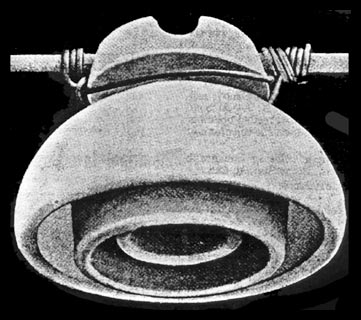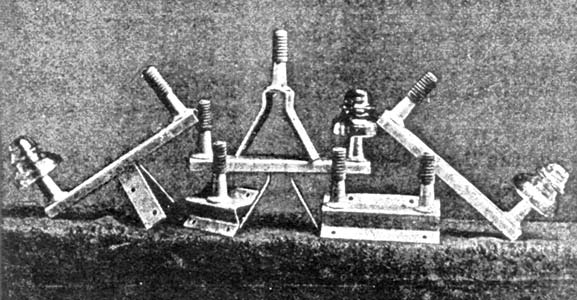[Trade Journal]
Publication: Electrical Review
New York, NY, United States
p. 55, col. 1-2
Locke's High Insulation Line Material.
In no department of engineering has it been so fully or so frequently demonstrated that good work and good material pay as in the field of the applications of electrical power. Cheap devices, like cheap labor, mean a constantly increasing repair account. The reduction of this often unnecessarily large item of expense means dividends to the operating company.
 |
| Fig. 1. — Locke's Indestructible Steel Insulator Pin. |
Mr. Fred M. Locke, of Victor, N. Y., has devoted especial attention to the development of high-grade insulating devices and now has on the market an extensive line of indestructible steel pins, break arms, side brackets, glass and porcelain insulators of high insulation; poles, fittings, cross-arms, braces and line material of all kinds. The steel pin shown in Fig. 1 is made with a steel bolt passing from the top of the pin through a half-inch hole in the cross-arm, and is securely fastened on the under side by a nut and washer. The iron cap between the top of the insulator pin and the cross-arm serves as a brace to resist the strain of the pull on the pin and at the same time covers the pin-hole in the cross-arm, thereby keeping out water and moisture and preserving the arm.
| |||
| Fig. 2. — Locke's Triple Petticoat China Insulator. |
In Fig. 2 is shown a triple petticoat insulator made of the highest grade chinaware obtainable. It measures 5-1/4 inches in diameter and 4 inches in height, and has over 12 inches of surface between the wire contact and the supporting pin. About 10 inches of this surface is on the under side of the insulator, out of reach of direct rainfall, where it keeps comparatively dry. The surfaces of the bottom of the insulator are perpendicular and therefore catch no foreign matter. By repeated practical tests it has been found that a potential of 85,000 volts is required to puncture the insulator, hence it will carry with safety and economy any voltage that is practicable for use in commercial application of electric power. The body and glaze are of simple earths only, fused together into a vitreous, homogeneous mass at the greatest heat. No lead or other metallic oxide being used in making, the glaze is not a conductor. The body and glaze being of exactly the same material and fired at the same heat, the insulating qualities are as high without as with the glaze. These insulators will not craze or crackle on the surface or "leak," as insulators made of inferior material will do when subjected to variations of temperature. The ware used in their construction will stand severe tensile strains or heavy blows without injury and will not crack or chip from the effects of high potential currents.
| |||
| Fig. 3. — Locke's Pole Fittings. |
Specimens of Mr. Locke's patented pole fittings are illustrated in Fig. 3.


